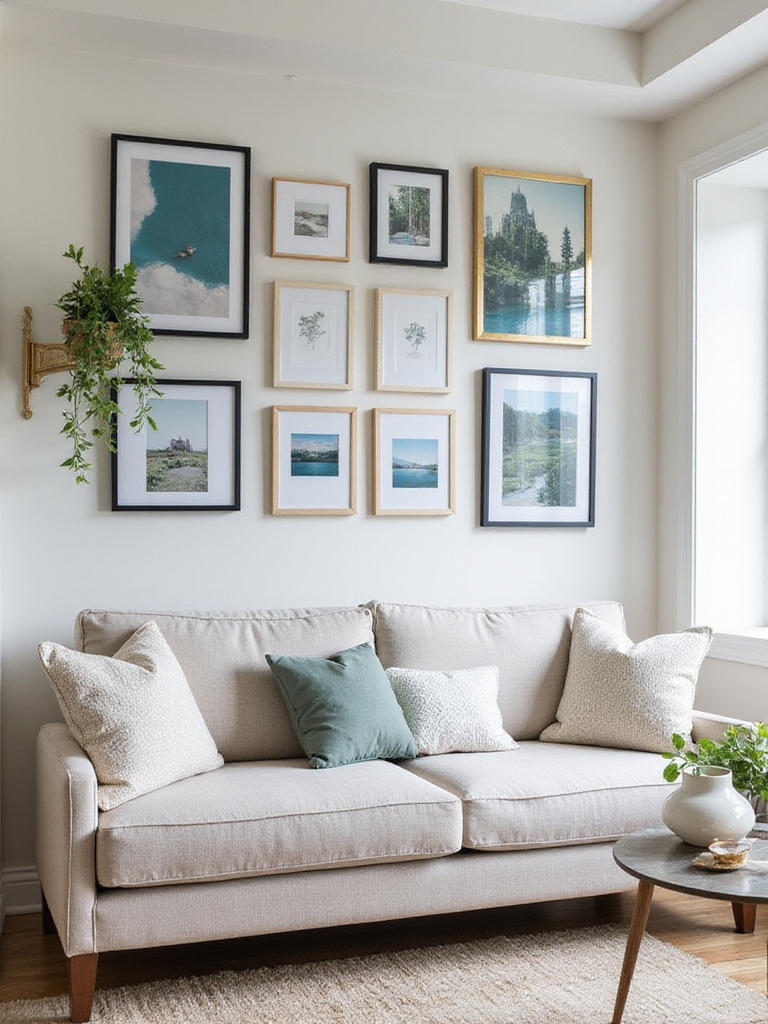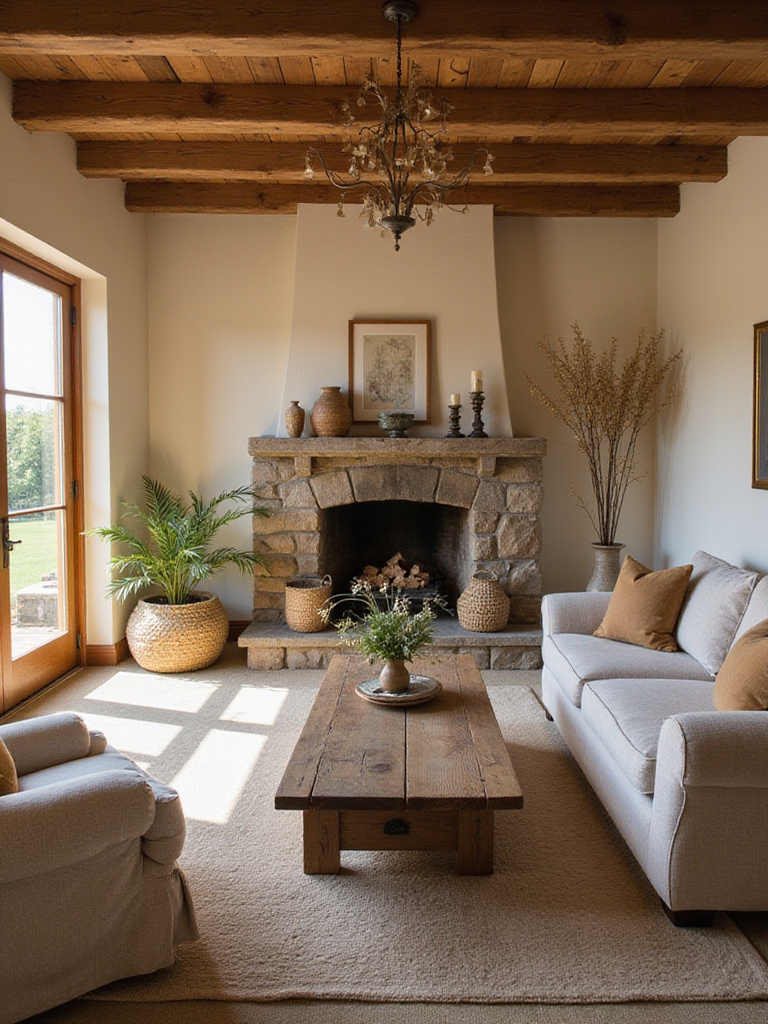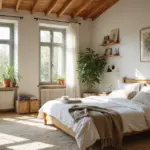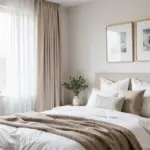Is your living room feeling a bit stale? As both an artist and space planning expert, I’ve seen how the right furniture can transform a lackluster room into a vibrant creative sanctuary. The living room isn’t just another space—it’s where life happens, where creativity flows, and where you should feel most at home.
After years of designing artist live-work spaces, I’ve gathered these 22 living room furniture inspirations to help you reimagine your space. Whether you’re a fellow artist needing functional beauty or simply someone craving a refresh, these ideas will spark your imagination and guide you toward a living room that truly feels like you.
1. Embrace the Statement Sofa: Make it Your Living Room’s Focal Point
A statement sofa isn’t just bigger or brighter—it’s a deliberate design choice that commands attention the moment someone enters your room. While regular sofas blend in, statement pieces stand out through vibrant colors, luxurious textures like velvet or bouclé, or unique silhouettes with sculptural elements. As an artist, I’ve found that the right sofa can anchor a room’s entire color story and set the creative tone for the space.

When selecting your statement piece, balance is key. Consider your room’s proportions—an oversized sofa can overwhelm a small studio space. Think about your lifestyle too. Do you need a durable fabric for art projects? Will this be where you curl up with sketchbooks? The right statement sofa should reflect both your aesthetic vision and practical needs, creating a beautiful foundation for your living room furniture inspiration.
“A statement sofa isn’t just furniture—it’s the canvas upon which the rest of your living room story unfolds.”
Here’s where it gets interesting: your sofa choice sets the stage for everything else, including the next versatile seating option that might just revolutionize your space.
2. Sectional Sophistication: Maximize Seating and Style with a Versatile Sectional
Sectional sofas bring remarkable benefits that traditional sofa-loveseat combinations simply can’t match. In my studio apartment designs, I’ve found sectionals to be game-changers for artists who need flexible spaces. They maximize seating without requiring multiple pieces, perfect for hosting critique sessions or collaborative work. Their ability to define conversation areas within open floor plans makes them especially valuable in live-work spaces where boundaries matter.

The right sectional configuration depends entirely on how you use your space. L-shaped sectionals work brilliantly in corners, perfect for smaller studios where every inch counts. U-shaped designs create intimate gathering spaces ideal for creative discussions. For artists who constantly rearrange their spaces, modular sectionals offer unparalleled flexibility—reconfigure them for a drawing session one day and a gallery opening the next. Chaise sectionals provide that perfect spot to stretch out while reviewing portfolios or sketching new ideas.
- Consider a performance fabric for sectionals in active studio spaces
- Look for sectionals with storage to hide art supplies
- Choose neutral colors if you display colorful artwork nearby
The plot thickens when we add accent chairs to the mix—those personality-filled pieces that can transform a functional seating arrangement into something truly special.
3. Armchair Allure: Discover Accent Chairs That Add Personality and Comfort
When choosing accent chairs for your living room, consider both style cohesion and functional purpose. I always ask my artist clients: What will this chair actually do? Will it be a cozy reading nook for art books? A place for guests during studio visits? The chair’s purpose should guide its form. Material choices matter tremendously—I’ve seen beautiful accent chairs rendered useless because the fabric was too precious for everyday use. Remember that an accent chair should be a joy to sit in, not just to look at.

To make accent chairs focal points, placement becomes your artistic tool. I often position a distinctive chair near natural light for clients who sketch or read. The contrast between a boldly colored chair and a neutral sofa creates visual tension that draws the eye exactly where you want it. For maximum impact, consider chairs with architectural elements—perhaps sculptural arms or an interesting silhouette. Lighting plays a crucial role too; a well-placed floor lamp can transform an ordinary chair into a dramatic statement piece.
- Swivel chairs add functionality in multi-purpose creative spaces
- Vintage accent chairs bring character and often better craftsmanship
- Consider washable slipcovers for chairs in active studio environments
The heart of the matter is that your living room arrangement needs a central anchor beyond seating—which is where the humble yet mighty coffee table enters our living room furniture inspiration journey.
4. Coffee Table Conversations: Choose a Centerpiece That’s Both Functional and Chic
The perfect coffee table balances size, function, and style in harmony with your living space. In my artist live-work designs, I’ve found that coffee table proportions make or break a room’s flow. For smaller studios, round tables prevent painful hip checks when moving between work areas. In larger spaces, substantial rectangular tables can define seating zones and provide ample surface area for creative work. Your lifestyle should dictate features—artists need durable, stain-resistant surfaces that forgive coffee spills during late-night creation sessions.

Functionality doesn’t mean sacrificing style. I often recommend lift-top tables to my clients who sketch in their living rooms—they instantly transform into proper work surfaces. For those who host critique sessions, tables with hidden storage keep portfolios and art books accessible but out of sight. Material choices speak volumes: reclaimed wood brings organic warmth, glass creates visual lightness in cramped spaces, and concrete offers industrial durability for working artists. The most successful coffee tables I’ve designed serve multiple functions while still making a clear aesthetic statement.
Quick Tip: Place a clear acrylic tray on upholstered ottomans to create a stable surface for drinks or art supplies without committing to a hard-top coffee table.What complicates this further is the need for supplementary surfaces—those smaller but equally important side tables that complete your living room furniture inspiration puzzle.
5. Side Table Savvy: Small Tables, Big Impact for Convenience and Design
Height alignment is the unsung hero of successful side table selection. I always tell my clients that side tables should be within 3 inches of their adjacent seating’s arm height—any higher feels awkward, any lower requires an uncomfortable reach. In tight artist studios, I recommend nesting tables that can expand when needed for creative work and contract when space is at a premium. Consider your daily habits too—do you need a place for coffee while sketching? Is a charging station essential? These functional needs should guide your choice.

Side tables offer perfect opportunities to introduce contrasting materials that would overwhelm larger pieces. In a living room with a plush velvet sofa, a raw metal side table creates beautiful tension. For spaces dominated by hard surfaces and clean lines, a side table with organic, curved elements provides visual relief. I often use side tables as “personality pieces” in minimal spaces—perhaps a vintage find with history or a sculptural piece that doubles as art. These small surfaces become perfect stages for vignettes that tell your story through carefully selected objects.
- C-tables that slide under sofas save valuable floor space in small studios
- Consider height-adjustable side tables for flexible work surfaces
- Look for side tables with built-in lighting for multifunctional benefits
The missing piece is often found in transitional areas—those in-between spaces where console tables shine as both functional workhorses and style statements.
6. Console Table Chic: Elevate Entryways and Living Rooms with Stylish Consoles
Console tables brilliantly solve multiple design challenges in one elegant piece. In my studio apartment designs, I’ve used them as makeshift room dividers, creating gentle transitions between living and working zones without walls. They excel at defining entryways in open floor plans, establishing a clear threshold between outside and in. Functionally, they’re unmatched for creating drop zones for everyday essentials—keys, mail, bags—keeping them from cluttering creative spaces. In living rooms proper, they transform dead wall space into useful display areas for rotating art collections.

The style versatility of console tables makes them chameleons in any design scheme. For minimal, contemporary spaces, I recommend sleek metal and glass consoles that visually disappear while providing function. Artists with eclectic tastes often prefer vintage consoles with character and patina that tell stories. In smaller studios, I look for console tables with substantial storage—drawers for art supplies, shelves for portfolios, hidden compartments for less attractive necessities. The narrow profile of console tables makes them perfect for tight spaces where every inch matters.
“A well-chosen console table acts as both the backbone and jewelry of a room—structurally important yet beautifully decorative.”
The game-changer happens when we introduce truly multi-functional pieces that transform according to your needs—and ottomans lead this versatility parade in our living room furniture inspiration collection.
7. Ottoman Oasis: Versatile Ottomans for Extra Seating, Footrests, or Tables
Ottomans might be the hardest working furniture in any living room. As an artist who designs live-work spaces, I’ve seen ottomans save countless square feet in small studios. Their shape-shifting nature—seating one moment, footrest the next, impromptu table after that—makes them invaluable in creative spaces where flexibility reigns supreme. When clients host gallery openings or critique sessions, ottomans provide casual seating that can be easily repositioned, then return to coffee table duty afterward.

The style spectrum for ottomans is gloriously wide. Traditional tufted versions bring classic elegance to formal spaces, while sleek leather cubes complement contemporary aesthetics. For bohemian artist studios, I often recommend poufs in textural fabrics that add warmth and informality. Storage ottomans perform double-duty magic—hiding art supplies, extra bedding for overnight guests, or seasonal items while still serving their primary functions. The best ottomans I’ve incorporated into designs consider both their aesthetic contribution and their practical applications.
- Round ottomans soften rooms dominated by rectangular furniture
- Consider casters for ottomans that need to move frequently
- Look for washable covers in studios where art-making happens
The foundation beneath all these pieces deserves equal attention—the humble rug that grounds your living room furniture inspiration and defines your creative territory.
8. Ruggedly Refined: Anchor Your Space with a Living Room Rug That Defines the Room
A well-chosen rug does invisible yet essential work in defining your living area. In open studio layouts I’ve designed, rugs create “rooms” without walls, establishing clear boundaries between living, working, and sleeping zones. They visually connect furniture pieces into cohesive conversational groupings rather than floating islands. The rug’s color, pattern, and texture set the tone—whether it’s a neutral backdrop letting your furniture shine or a bold statement piece that anchors everything else.

Selecting the perfect rug requires balancing multiple factors. Size matters tremendously—too small and the rug looks like an afterthought; too large and it can overwhelm the space. For artist studios where painting happens, I recommend polypropylene rugs that resist stains and can be hosed off when inevitable spills occur. Natural fibers like wool bring warmth but require more maintenance. Consider traffic patterns too—high-pile luxury feels wonderful underfoot but can trap art debris and wear quickly in studio environments. The right rug should complement your living room furniture inspiration while standing up to your creative lifestyle.
Designer Tip: In small spaces, choose a rug large enough to fit at least the front legs of all seating on it—this visually expands the room while unifying the furniture arrangement.Now that we’ve grounded our space, let’s add those layers of comfort and color that transform furniture into a truly inviting environment—starting with the humble yet mighty throw pillow.
9. Pillow Power: Inject Color and Texture with Decorative Throw Pillows
Finding pillow balance is both art and science. After years of designing artist live-work spaces, I’ve discovered that the right number depends not just on sofa size but on how the space is actually used. For a working studio where the sofa doubles as client seating, 3-5 pillows provide comfort without becoming obstacles. For a purely residential space where lounging is primary, 5-7 pillows create that sink-in comfort many crave. The key question isn’t just quantity but placement—pillows should enhance, not hinder, the sofa’s primary function.

The magic happens when mixing patterns, textures, and sizes. I start by selecting a color story—perhaps pulling a secondary shade from a nearby painting or textile. Then I play with pattern scale: a large geometric, a medium floral, and a small texture create visual rhythm without chaos. Varying textures adds tactile interest—perhaps velvet against linen against knit. For artist spaces, I recommend pillow covers that zip off for washing, knowing that creative environments invite happy accidents. The most successful pillow arrangements feel curated rather than matched, telling a color story that complements your living room furniture inspiration.
- Rotate pillow covers seasonally for an instant refresh
- Include at least one solid pillow to give the eye a resting place
- Consider outdoor-grade fabrics for exceptional durability in working studios
The breakthrough came when designers realized that comfort extends beyond pillows—throw blankets add another essential layer of texture and warmth to living room furniture inspiration.
10. Throw Blanket Bliss: Add Cozy Comfort and Style with Luxurious Throws
Material selection dramatically impacts both the aesthetic and practical aspects of throw blankets. For artist studios that double as living spaces, I recommend washable materials that can stand up to creative messes. Merino wool offers remarkable warmth without bulk and naturally resists stains. For purely decorative throws in formal areas, cashmere brings unmatched luxury. In warmer climates or for summer use, cotton and linen throws provide just enough warmth for air-conditioned evenings while adding textural interest to your living room furniture inspiration.

Size and color choices should complement your existing décor while fulfilling practical needs. For standard sofas, I typically recommend throws around 50×60 inches—large enough to actually use but not so massive they overwhelm the furniture. On sectionals, larger throws (60×80) provide better scale balance. Color selection provides another opportunity to tie your palette together—perhaps picking up an accent tone from artwork or introducing a complementary hue that enhances existing colors. The most successful throws look intentional rather than afterthoughts, carefully chosen to enhance both comfort and visual appeal.
- Drape throws in different ways for varied looks—folded neatly for formal settings, casually draped for relaxed vibes
- Consider weighted throws for studios where relaxation after intense creative work is important
- Look for throws with interesting weave patterns for added visual texture
The heart of the matter is that even the most beautiful furniture arrangement falls flat without proper illumination—lighting layers bring your living room furniture inspiration to life.
11. Lighting Layers: Create Ambiance with a Mix of Floor, Table, and Accent Lamps
Layered lighting transforms living rooms from flat to multidimensional. In artist studios I’ve designed, proper lighting isn’t just aesthetic—it’s essential for accurate color perception and detail work. A single overhead light creates harsh shadows and flattens the space. By contrast, thoughtfully layered lighting—ambient, task, and accent—creates depth, highlights architectural features, and allows the room to transition from workday focus to evening relaxation. This flexibility is particularly valuable in live-work spaces where the room must serve multiple functions.

Implementing effective lighting layers requires strategic placement. I typically start with ambient lighting—perhaps a central fixture or torchiere floor lamp—to provide general illumination. Then I add task lighting near seating areas where reading, sketching, or detailed work happens. Finally, accent lighting highlights artwork, architectural features, or decorative objects. The most successful lighting plans I’ve created allow for independent control of each layer, using dimmers or separate switches to adjust the mood as needed. This approach ensures your living room furniture inspiration looks its best in any lighting scenario.
- Consider color temperature—warmer lights (2700K-3000K) create coziness, while cooler lights (4000K+) enhance focus
- Look for adjustable-arm lamps that can redirect light as needed
- Include at least one unexpected lighting element—perhaps a sculptural table lamp that doubles as art
The puzzle becomes complete when we consider not just what sits on your floors but what adorns your walls—shelving solutions that balance display and storage needs.
12. Shelving Solutions: Showcase Your Style with Decorative and Functional Shelves
Selecting the right shelving requires honest assessment of both storage needs and aesthetic goals. In artist live-work spaces, I prioritize functionality—adjustable shelves accommodate changing storage needs as projects evolve. Open shelving works beautifully for displaying portfolios, art books, and inspiration pieces that benefit from visibility. Closed storage becomes essential for supplies, tools, and less attractive necessities. The most successful shelving solutions I’ve designed blend both types, creating a balance between display and concealment that keeps spaces feeling organized yet personal.

Strategic placement transforms ordinary shelves into powerful focal points. I often design asymmetrical arrangements that create visual interest while maximizing storage. Floating shelves installed at varying heights create dynamic wall compositions that double as art displays. For maximum impact, consider the negative space between shelves as carefully as the shelves themselves—this breathing room prevents visual clutter. Lighting integrated into shelving—whether recessed strips or strategically placed picture lights—elevates the entire arrangement, highlighting special pieces and creating depth through shadow play.
- Group similar items together for visual cohesion
- Leave 30% of shelf space empty to prevent crowded looks
- Incorporate plants to bring life to shelving arrangements
You might be wondering about those items that don’t belong on display—that’s where cabinet solutions enter our living room furniture inspiration conversation.
13. Cabinet Charm: Conceal Clutter and Add Elegance with Stylish Cabinets
Cabinets offer the perfect solution for maintaining visual serenity in creative spaces. As someone who designs for artists, I’ve seen how quickly supplies, works-in-progress, and reference materials can overwhelm a living area. Well-chosen cabinets provide essential boundaries between work and relaxation. They conceal the necessary chaos of creative processes while presenting a composed face to the world. Beyond mere storage, cabinets anchor rooms, add architectural interest to plain walls, and introduce materials and finishes that enhance your overall design scheme.

The cabinet style you choose dramatically impacts your living room’s personality. Modern cabinets with clean lines and minimal hardware create a sense of order perfect for contemporary spaces. Traditional cabinets with glass fronts and interior lighting beautifully display collections while keeping them dust-free. For artist studios, I often recommend industrial-inspired cabinets with durable finishes that withstand creative messes. Mid-century modern cabinets on tapered legs add vintage charm while keeping floor space visually open—crucial in smaller live-work environments where airiness matters.
“The best cabinets are like good assistants—they handle the background work seamlessly so the stars of your space can shine.”
The surprising part is how strategically placed mirrors can make even cabinet-heavy rooms feel spacious and light—our next essential element in living room furniture inspiration.
14. Mirror Magic: Expand Your Space and Enhance Light with Strategically Placed Mirrors
Mirrors perform optical illusions that transform small spaces. In compact artist studios I’ve designed, large mirrors strategically placed opposite windows effectively double the perceived space and multiply natural light. This visual expansion creates breathing room in tight quarters. The key is careful placement—a mirror reflecting a cluttered area simply amplifies visual noise. Instead, position mirrors to capture views of outdoor greenery, architectural details, or your most beautiful furniture pieces. This selective reflection curates what the eye perceives, making small spaces feel more generous.

Light amplification might be mirrors’ most valuable contribution to living spaces. Natural light is precious currency in creative environments where color accuracy matters. By positioning mirrors to catch and redirect window light, you can illuminate shadowy corners and reduce reliance on artificial lighting. For evening ambiance, mirrors placed near lamps or candles multiply their glow, creating a warmer, more intimate atmosphere. The most successful mirror placements I’ve created consider both daytime and nighttime lighting patterns, enhancing both equally.
- Consider antiqued or smoked mirror for vintage charm with less stark reflection
- Round mirrors soften rooms dominated by rectangular furniture and architecture
- Leaning floor mirrors create depth while avoiding wall damage in rental spaces
What many people overlook is how living elements transform a space—greenery brings vitality to our living room furniture inspiration that no manufactured item can match.
15. Greenery Galore: Bring Life Indoors with Plants and Natural Elements
Plants contribute to living spaces in ways that transcend mere decoration. As someone who designs creative environments, I’ve observed how plants physically improve air quality by removing toxins—particularly important in studios where art materials may introduce chemicals. The psychological benefits are equally significant; studies consistently show that proximity to plants reduces stress and improves focus—essential for both creative work and relaxation. Visually, plants add organic shapes and movement to rooms otherwise dominated by static, geometric furniture, creating dynamic contrast that enlivens the entire space.

For busy artists and professionals, several low-maintenance plant options thrive with minimal attention. Snake plants tolerate inconsistent watering and low light conditions, making them perfect for studios with irregular schedules. ZZ plants similarly forgive neglect while adding glossy, architectural foliage. Pothos vines grow dramatically with little care, softening shelving and creating vertical interest. For those with bright spaces, succulents offer sculptural forms that complement modern living room furniture inspiration. The key is matching plants to your specific light conditions and maintenance capacity—even the most beautiful plant becomes a disappointment if it can’t thrive in your environment.
- Group plants of different heights for visual interest
- Consider plant placement in relation to creative work areas—some plants filter air better than others
- Rotate plants occasionally so all sides receive light, promoting even growth
Let’s paint you a picture of how wall art complements these living elements, creating a complete visual story in your space.
16. Wall Art Wonders: Express Your Personality with Eye-Catching Wall Décor
Common wall art mistakes can undermine even the most thoughtful living room furniture inspiration. The most frequent error I see is selecting artwork that’s proportionally mismatched to the wall—tiny pieces floating in vast spaces or oversized works overwhelming smaller walls. Another pitfall is hanging art too high; the center of artwork should generally sit at eye level (about 57-60 inches from the floor). Many people also rush art selection, choosing generic pieces that lack personal connection rather than waiting for work that resonates emotionally. In artist spaces particularly, I encourage clients to display their own creations alongside collected pieces, creating a gallery that truly reflects their creative journey.

Selecting wall art that complements your furniture requires considering both visual harmony and meaningful contrast. Start by evaluating your furniture’s characteristics—is it angular or curved? Bold or subtle? Then consider art that either reinforces these qualities or provides intentional counterpoint. For instance, organic, flowing artwork softens rooms dominated by geometric furniture, while structured, graphic pieces add definition to softer, more casual arrangements. Color relationships matter tremendously; art can either echo your furniture’s palette for cohesion or introduce complementary colors for energy and interest. The most successful living rooms I’ve designed use art as conversation between furniture and walls, creating dialogue rather than competition.
- Consider creating a gallery wall that can evolve over time with new acquisitions
- Use picture ledges for flexible displays that can be changed without making new holes
- Think beyond traditional framed art—textiles, sculptures, and dimensional pieces add unexpected interest
The plot thickens when we consider how different furniture styles create entirely different moods—starting with the clean simplicity of modern minimalism.
17. Modern Minimalism: Embrace Clean Lines and Uncluttered Spaces
Modern minimalist furniture creates impact through intentional restraint. The defining characteristics include clean geometric forms without unnecessary ornamentation, allowing the essential beauty of each piece to speak for itself. Materials are typically honest and unadorned—natural wood with visible grain, brushed metal, clear glass—celebrating their inherent qualities rather than disguising them. Color palettes remain controlled and neutral, creating visual calm and allowing architectural elements to shine. Low-profile silhouettes predominate, keeping sight lines open and emphasizing spaciousness. In artist live-work spaces, this aesthetic clarity provides a mental palate cleanser—a visual rest from creative stimulation.

Achieving minimalism without sacrificing comfort requires strategic choices. Instead of numerous mediocre pieces, invest in fewer high-quality items that excel in both form and function. Look for minimalist furniture with hidden depth—perhaps a seemingly simple sofa with exceptional ergonomic design, or a sleek storage piece with thoughtful internal organization. Introduce textural variation through natural materials and subtle pattern to prevent sterility—perhaps a nubby wool rug against smooth concrete floors, or linen upholstery against polished wood. The most successful minimalist spaces I’ve designed maintain warmth through material contrast while eliminating visual clutter, creating environments that feel both serene and inviting.
- Choose multi-functional pieces that eliminate the need for additional furniture
- Incorporate one statement piece as a focal point among otherwise quiet elements
- Consider the negative space between furniture as an active design element
Things took an unexpected turn when we contrast this restraint with the joyful exuberance of bohemian style—another powerful direction for living room furniture inspiration.
18. Bohemian Rhapsody: Mix and Match Textures and Patterns for a Relaxed Vibe
Bohemian living rooms celebrate personal expression through eclectic combinations. The defining elements include layered textiles—from Moroccan rugs to Indian throws to macramé wall hangings—creating rich tactile experiences. Low-slung furniture encourages casual gathering, often featuring floor cushions and poufs alongside conventional seating. Natural materials predominate, with rattan, bamboo, and reclaimed wood bringing organic warmth. Pattern mixing becomes an art form, with florals, geometrics, and global motifs coexisting in vibrant harmony. Plants feature prominently, reinforcing connection to nature and adding life. The overall effect feels collected rather than designed, evolving organically over time rather than arriving all at once.

Successfully mixing patterns and textures without chaos requires finding unifying elements. In bohemian spaces I’ve designed, I typically establish a consistent color story—perhaps jewel tones or earth hues—that threads through diverse patterns, creating cohesion amid variety. Varying pattern scale prevents competition; a large-scale floral works harmoniously with a small-scale geometric when they share color notes. Texture provides visual breaks between patterns—perhaps a solid velvet pillow between two patterned ones, or a smooth wooden table among textured textiles. The most successful bohemian rooms feel intentionally curated rather than randomly assembled, with each element contributing to a cohesive yet free-spirited whole.
- Start with larger neutral pieces (sofa, rug) then layer in pattern through smaller items
- Mix cultural influences respectfully, understanding the origins of decorative elements
- Allow negative space between vignettes to prevent overwhelming the eye
When we look beneath the surface of design trends, we discover that rustic elements bring a grounding authenticity to living room furniture inspiration that many spaces crave.
19. Rustic Retreat: Infuse Warmth with Natural Wood and Cozy Farmhouse Furniture
Rustic retreat living rooms evoke sanctuary through specific design elements. Natural materials form the foundation—especially wood and stone with visible texture and character. Comfortable, generous seating invites relaxation, often featuring overstuffed cushions and soft, touchable fabrics. Warm color palettes of earth tones and neutrals create visual comfort, reminiscent of natural landscapes. Architectural details like exposed beams or stone fireplaces anchor the space with authenticity. The overall feeling is one of unpretentious welcome—spaces that encourage lingering conversations and quiet contemplation, perfect for artists seeking respite from intensive creative work.

Certain wood types particularly enhance rustic aesthetics through their inherent character. Reclaimed wood tells stories through its patina, nail holes, and weathering—each mark representing history and authenticity. Pine, with its prominent knots and grain variations, brings casual warmth even when new. Oak offers timeless strength and distinctive grain patterns that improve with age. Cedar contributes both visual warmth and aromatic qualities, enhancing the sensory experience of the space. In rustic-inspired studios I’ve designed, these woods create connections to nature that balance the sometimes cerebral nature of creative work, grounding the space in tactile reality.
- Incorporate textural contrasts—rough wood against soft upholstery, smooth stone against nubby textiles
- Choose pieces with visible joinery that celebrates craftsmanship
- Look for furniture with history or the appearance of having been loved
The underlying pattern reveals that sometimes our spaces crave a touch of luxury—which leads us to glamorous living room furniture inspiration that elevates everyday life.
20. Glamorous Getaway: Elevate Your Space with Luxe Fabrics and Metallic Accents
Luxurious fabrics transform ordinary furniture into extraordinary statements. For truly glamorous living rooms, velvet stands supreme—its light-catching pile creates depth and richness unmatched by flatter fabrics. The weight and drape of velvet upholstery elevates even simple forms into something special. Silk, whether in pillows or drapery, adds luminous sheen that changes subtly as light shifts throughout the day. Faux fur introduces textural drama and tactile pleasure, perfect for throws and accent pillows. Even in artist studios where practicality matters, these luxe fabrics can be incorporated strategically—perhaps a velvet chair in a low-traffic area or silk pillows that add glamour without compromising function.

Metallic accents require strategic restraint to maintain sophistication. I typically recommend selecting just one primary metallic tone per room—gold for warmth, silver for coolness, or brass for vintage charm. Use these metallic elements as jewelry for your space—think lamp bases, picture frames, decorative objects, or furniture legs rather than large-scale applications. The placement should feel intentional rather than random, perhaps creating a subtle rhythm throughout the room. In artist spaces where creativity reigns, metallics can reflect studio lighting in interesting ways, adding dynamic visual elements that change as you move through the space.
- Mix metallic finishes with matte textures for balanced contrast
- Consider metallic-flecked textiles for subtle shimmer
- Use mirrors with metallic frames to amplify light and metallic reflections
Just when everything seemed straightforward, we discover that certain fabrics deserve special attention—particularly velvet, which brings unique qualities to living room furniture inspiration.
21. Velvet Vibes: Indulge in Luxurious Velvet Upholstery for Sofas and Chairs
Velvet upholstery offers distinct advantages that extend beyond mere aesthetics. Its plush pile creates unmatched tactile comfort, inviting touch and relaxation. Modern performance velvets resist stains and wear surprisingly well, making them more practical than their luxurious appearance suggests. The dimensional quality of velvet creates visual depth through light play—as light hits the pile from different angles, the color appears to shift subtly, adding visual interest even to solid-colored pieces. In artist studios, this light-reactive quality can inspire color exploration and appreciation for how materials transform under different lighting conditions.

Color selection dramatically impacts velvet’s presence in your space. Jewel tones like emerald green, sapphire blue, and ruby red maximize velvet’s inherent richness, creating powerful focal points that anchor a room. These saturated colors showcase velvet’s ability to hold color with exceptional depth and intensity. Neutral velvets—grays, taupes, and ivories—offer more subtle sophistication, adding textural interest without color dominance. They integrate more easily into existing color schemes while still providing velvet’s distinctive tactile quality. Dark velvets in navy or charcoal create a sense of intimacy and coziness, perfect for spaces meant for evening relaxation or contemplative creative work.
Quick Tip: Test velvet upholstery by running your hand across it in different directions—quality velvet will show distinct color variation as the pile shifts, creating that characteristic dimensional effect.The real story emerges when we examine how natural materials like wood create foundation pieces that endure beyond trends in living room furniture inspiration.
22. Natural Wood Wonders: Incorporate Wood Furniture for Timeless Warmth and Beauty
Wood furniture maintains its timeless appeal through intrinsic qualities that manufactured materials simply cannot replicate. Each piece tells a unique story through grain patterns that are literally one-of-a-kind—nature’s fingerprint made visible. This authentic character creates connection to the natural world, something increasingly valuable in our digital age. Wood’s remarkable versatility allows it to be crafted into virtually any style, from rustic to refined, ensuring its relevance across changing trends. In artist spaces particularly, wood’s organic warmth balances the sometimes clinical nature of creative tools and technology, creating environments that feel nurturing rather than sterile.

Different wood species bring distinctive characteristics to living room furniture. Oak’s prominent grain and exceptional durability make it ideal for pieces that will see daily use—coffee tables, dining tables that double as work surfaces, sturdy shelving. Maple’s smoother, more uniform appearance creates a cleaner aesthetic perfect for contemporary spaces where subtle natural elements are desired. Walnut’s rich chocolate tones add sophistication and depth, creating natural focal points through color contrast. Cherry develops a distinctive patina over time, actually improving with age and use—a rare quality in our disposable culture. In artist studios, these living materials respond to their environment, developing character that reflects the space’s history and use.
- Consider how wood will age in your space—some species darken with sun exposure
- Mix wood tones thoughtfully for collected rather than matched look
- Look for sustainable harvesting certifications when purchasing new wood furniture
Conclusion: Your Living Room, Your Story
These 22 living room furniture inspirations offer starting points for creating a space that truly reflects who you are. As an artist and space planner, I’ve seen how the right furniture transforms not just rooms but experiences—how a well-chosen sofa becomes the site of creative breakthroughs, how the perfect chair cradles you through late-night inspiration sessions, how thoughtful storage solutions make creative chaos manageable.
Remember that your living room furniture should support both your aesthetic vision and practical needs. Whether you’re drawn to the clean simplicity of minimalism, the eclectic warmth of bohemian style, or something entirely your own, let your choices tell your unique story. After all, the most inspiring living rooms aren’t the ones that follow trends perfectly—they’re the ones that feel authentically, unmistakably yours.






